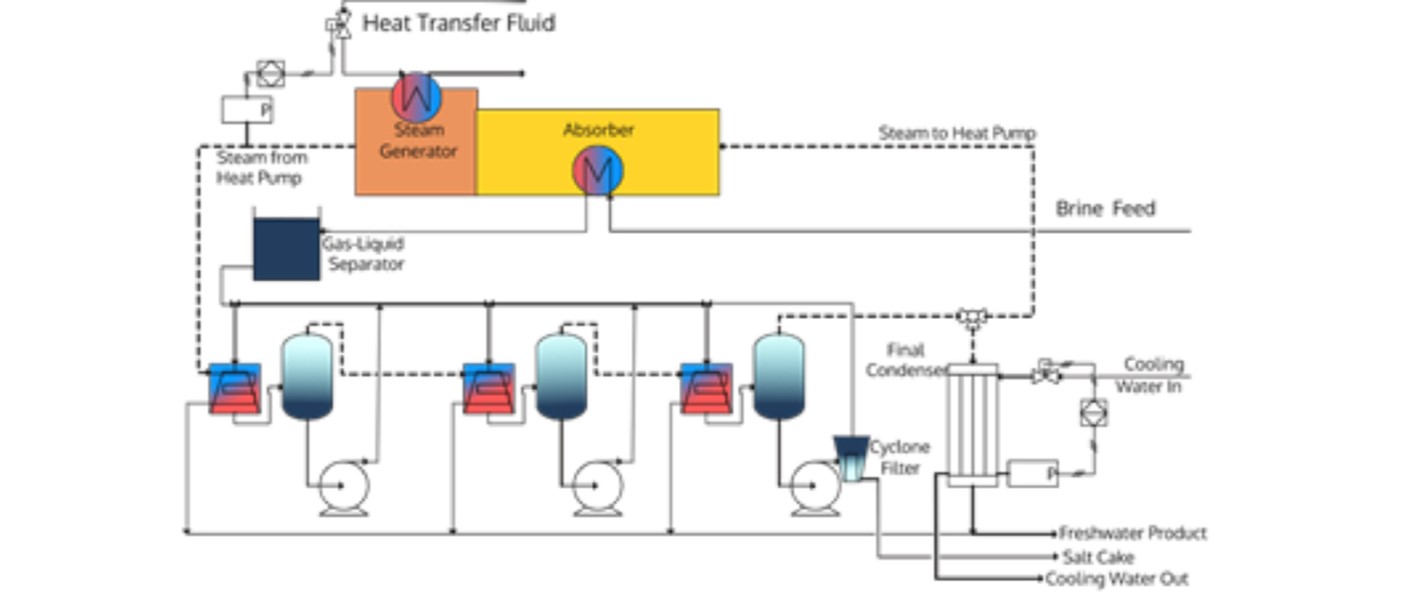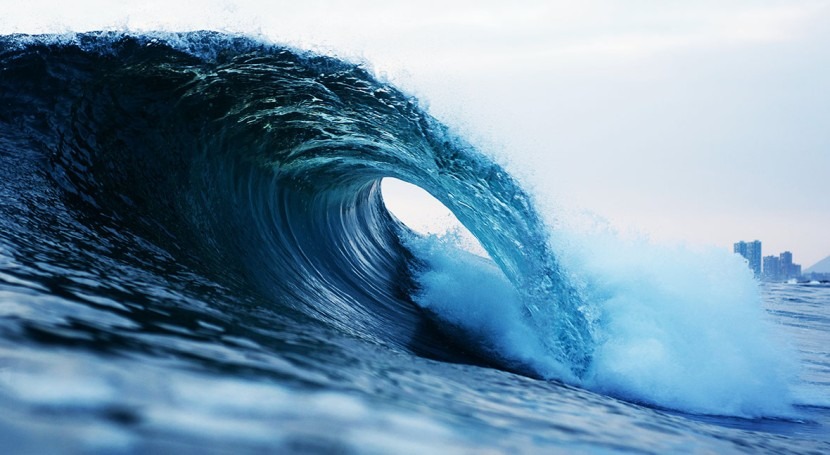Understanding the properties of brines is critical in the design, control, and optimization of brine concentrator treatment systems. Typically, thermodynamic models are used to derive the properties of pure substances and dilute mixtures. However, these models are largely incomplete because salt behavior in highly concentrated brines is poorly understood. Additionally, traditional theories and models have significant limitations when applied to aqueous solutions as concentrated and complex as brines from water treatment facilities. Moreover, available models have not been developed for modern simulation and optimization platforms and cannot support process intensification and digital twin applications.
The quest to comprehend the thermodynamic and kinetic phenomena in concentrated multi-electrolyte, mixed-solvent solutions, such as those in brines, is a century-old challenge dating back to Peter Debye’s pioneering work, which earned him the Nobel Prize in 1936.
This gap in understanding and technological capability is where National Alliance for Water Innovation (NAWI)-supported research steps in, aiming to develop a new, more accurate theory for the properties of high salinity brines. The research aims to generate thermodynamic, thermal, transport, and speciation data for concentrated brines. The research team will coordinate modeling and experimental efforts to design experiments for brine characterization, discover principal model dependencies, and tune models to accurately predict the properties of brines. This effort will culminate in the development of a new, open-source modeling library and framework, which will inform and refine existing NAWI tools such as the Water Technoeconomic Assessment Pipe Parity Platform (WaterTAP).
Bridging the gap: Innovative tools for modern water treatment
NAWI is a research program and public-private partnership that is instrumental in advancing a suite of open-source predictive multi-scale models designed for the optimization of water treatment processes and systems. WaterTAP, offers a robust platform for consistent technoeconomic assessments of desalination treatment trains, evaluating cost, energy, environmental, and resiliency trade-offs across diverse water sources, sectors, and scales. WaterTAP leverages open-source models and data indexed in the Water Data and Analysis Management Systems (Water DAMS) platform, which serves as NAWI’s primary data repository.
“The project aligns with the vision of Lawrence Berkeley National Laboratory and the United States Department of Energy for a sustainable future in the food-water-energy nexus,” said Peter Fiske, Executive Director of NAWI. "This is more than an academic exercise. It’s about creating practical tools that will ensure that every drop of water is used efficiently and responsibly.”
NAWI represents the largest federal investment in water treatment, desalination, and water reuse since the 1960s. Supported by the United States Department of Energy (DOE) in collaboration with the California Department of Water Resources and the California State Water Resources Control Board, NAWI unites a world-class team of industry and academic partners. Together, they address critical technical barriers and research needed to significantly reduce the cost, energy demands, and greenhouse gas emissions of desalination. NAWI is led by DOE’s Lawrence Berkeley National Laboratory (LBNL), in collaboration with the National Renewable Energy Laboratory, Oak Ridge National Laboratory, National Energy Technology Laboratory, and SLAC National Accelerator Laboratory.

Figure: Architecture of a heat integrated multi-effect brine concentrator to be designed and optimized using WaterTAP
From theory to practice: Revolutionizing water treatment design
The researchers will deploy and validate their models in WaterTAP and the Institute for Design of Advanced Energy Systems (IDAES) integrated modeling platform and certify that the models meet modern software standards. WaterTAP is built on the IDAES integrated platform, which uses the most advanced computational algorithms to enable the design and optimization of complex, interacting energy and process systems from individual plant components to the entire electrical grid. WaterTAP is made more powerful with the IDAES platform as its foundation. The certification of the WaterTAP platform will allow these models to be used for optimization, control, and monitoring of water treatment processes. The expected outcome is a significant disruption of existing practices in designing water treatment facilities by providing an open-source software platform that is accessible to all users.
George Bollas, Principal Investigator of the project, Professor of Chemical & Biomolecular Engineering, Director of the Pratt & Whitney Institute for Advanced Systems Engineering, and Associate Dean of Research for the College of Engineering at the University of Connecticut adds: "Our goal is to bridge the gap between traditional thermodynamic theories, advanced simulation software platforms, and modern water treatment needs. By developing more accurate models, amenable to robust mathematical optimization, we can optimize the design and operation of brine concentrator systems, ultimately enhancing their efficiency, and reducing cost and environmental impact."
Enabling the accurate simulation of concentrated brine solutions and treatment systems will allow for greater utilization and reuse of non-traditional water sources. This capability will facilitate out-of-the-box studies, and the re-design and operational optimization of existing systems.
A comprehensive approach to water research and development
This research is part of NAWI’s comprehensive portfolio of new water research and development initiatives. Ranging from water-energy grid integration analysis to developing algorithms, models, and adaptive process controls for resilient operations, NAWI is backing over sixty research and development projects to advance the affordability, sustainability, resilience, and efficiency of new water technologies. For additional information about NAWI’s research and projects, visit NAWI’s projects.
According to Jeffrey McCutcheon, a project collaborator, NAWI Deputy Topic Lead for Materials and Manufacturing, and the General Electric Professor of Advanced Manufacturing in the Chemical and Biomolecular Engineering Department at the University of Connecticut, "This project exemplifies the power of interdisciplinary collaboration. By combining our expertise in thermodynamics, process modeling, and water treatment, we are poised to deliver innovative solutions that address the pressing challenges of water scarcity."
The NAWI Alliance boasts a robust network of over 1,670 members and 420 research partners spanning industry, academia, and government sectors. NAWI provides numerous avenues for involvement, including Alliance membership and volunteer opportunities as a Project Support Group advisor. To express interest in joining the NAWI Alliance, simply complete the application to join the NAWI Alliance.
Advancing practical solutions for water scarcity
“Being part of the NAWI Alliance is immensely beneficial for our work. The support from NAWI means access to unparalleled resources, data, expertise, and collaborative opportunities,” said Bollas. “It empowers us to push the boundaries of water treatment research and make significant impacts. This partnership is vital in our mission to address water scarcity and enhance water reuse technologies.”
In an era where water scarcity is an escalating global concern, the significance of this research cannot be overstated. This research initiative marks a significant advance toward harnessing the full potential of desalination and brine concentration technologies, ensuring that we can meet the water needs of future generations. The efforts of NAWI and the research team promise to enhance the efficiency, reliability, and sustainability of water treatment systems, making pivotal strides in addressing one of the most pressing challenges of our time.
Author’s note: The views expressed in this column do not necessarily represent the views of the US Department of Energy or the US government.
Research Partners: Modelon, Inc.: Chen Chen, Hubertus Tummescheit; Sandia National Laboratories: Jordan Jalving; University of Connecticut: Edward Wazer, George Bollas, Jeffrey McCutcheon, Matthew Stuber.



